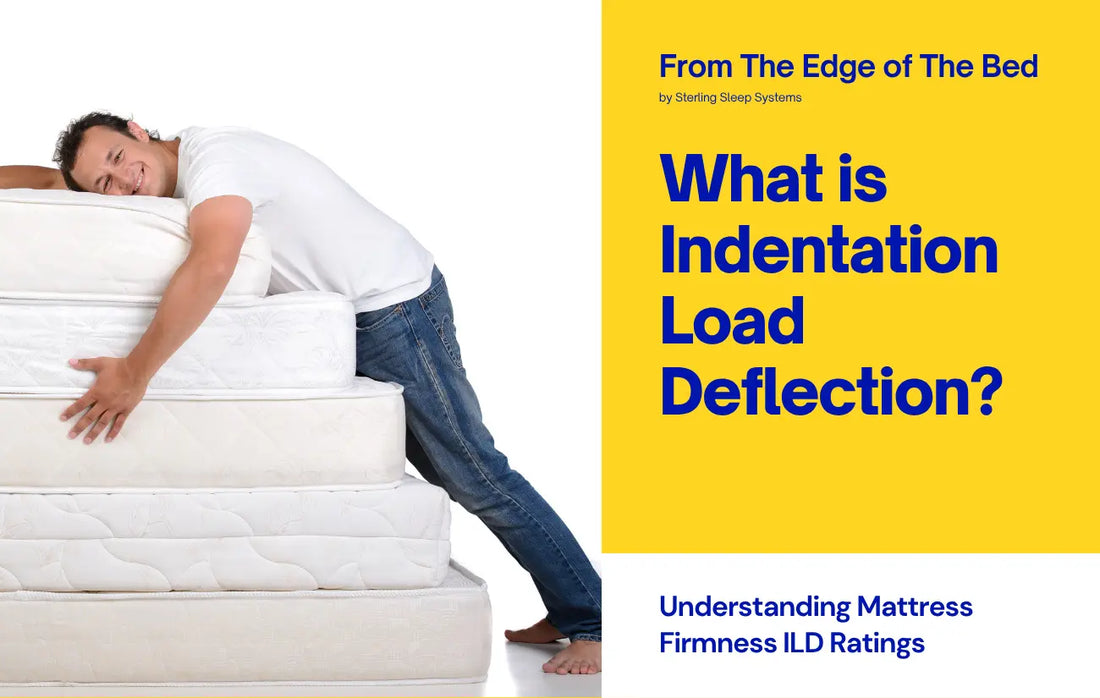
What Is ILD in Foam? Understanding Mattress Firmness Ratings
How do we Determin Mattress Firmness?
If you’ve been researching mattresses or foam products, you’ve likely come across the term ILD—short for Indentation Load Deflection. It’s an important concept in the mattress industry, especially when discussing the firmness of latex or polyurethane foam. At Sterling Sleep Systems, we’ve used this measure for decades to help customers understand the characteristics of different foam layers.
What Does ILD Measure?
ILD is a measurement that tells you how much pressure it takes to compress a piece of foam by 25% of its original height. The higher the ILD number, the firmer the foam. For instance, a foam with a 20 ILD will feel much softer than one rated at 40 ILD.
The test is performed by placing a foam sample in a machine that applies force and records how many pounds of pressure are required to reach a specified level of compression. The result is a consistent, reliable number used throughout the industry to compare foam firmness levels.

Is ILD a Standard Unit of Measure?
Yes—within the mattress and foam industries, ILD has become a de facto standard for measuring firmness. While some manufacturers may use different units like Newtons or “pounds per square inch,” ILD remains the most common and accessible method in the U.S. mattress market. Our suppliers use calibrated testing equipment to ensure consistency across batches.
For a deep dive into the science behind ILD, this article from Natural Mattress Finder offers excellent technical insights.
Why ILD Values Are Often a Range
Foam, especially natural latex, is produced in batches—and like baking, minor variations in temperature, humidity, and material can affect the outcome. That’s why ILD values are typically presented as a range.
For example, when we list an Extra Firm latex foam, we might give it a range of 36–44 ILD. In the past, we’ve offered foams rated as high as 50 ILD. If we order a 38 ILD, our supplier might send us a 36 or a 40—and that’s considered acceptable. These slight differences are normal and fall within industry tolerance levels.
ILD Applies to Individual Foam Layers—Not Entire Mattresses
It’s also important to know that ILD ratings apply to individual foam layers, not entire mattresses. A mattress may contain multiple layers—such as memory foam over latex or polyurethane foam—and each layer may have its own ILD value. These layers work together to create a combined feel, so ILD should be used as a guideline, not a precise predictor of total mattress firmness.
Our Perspective: Facts Over Fluff
At Sterling Sleep Systems, we’ve been building mattresses and waterbeds in the U.S. for nearly 40 years. We’ve seen countless trends and marketing gimmicks come and go—but one thing remains constant: transparency, durability, and informed choices matter.
We don’t claim to be the “#1 foam brand” or the “largest mattress company in America.” Frankly, those kinds of claims are hard to quantify. Instead, we focus on what we know best: designing high-quality sleep systems and sharing knowledge based on real-world experience.
Recently, we’ve seen newer brands suggest that ILD is outdated or irrelevant, favoring alternative metrics. While those methods are valid, ILD is still widely accepted and useful—when used properly and understood in context.
Want to Learn More?
If you’d like to explore ILD and foam firmness in more depth, here are a few trusted resources:
Note: ILD ratings apply to foam products such as latex and polyurethane foam. They do not apply to waterbeds, which use entirely different support and comfort systems.
Final Thoughts
ILD is a useful tool for comparing foam firmness and making informed purchasing decisions. While it's not a perfect system—due to natural variations in manufacturing—it gives consumers and manufacturers a consistent way to evaluate foam materials.
As always, if you have any questions about foam firmness or how ILD might relate to a product you’re considering, feel free to contact us. We’re here to help, not hype.
